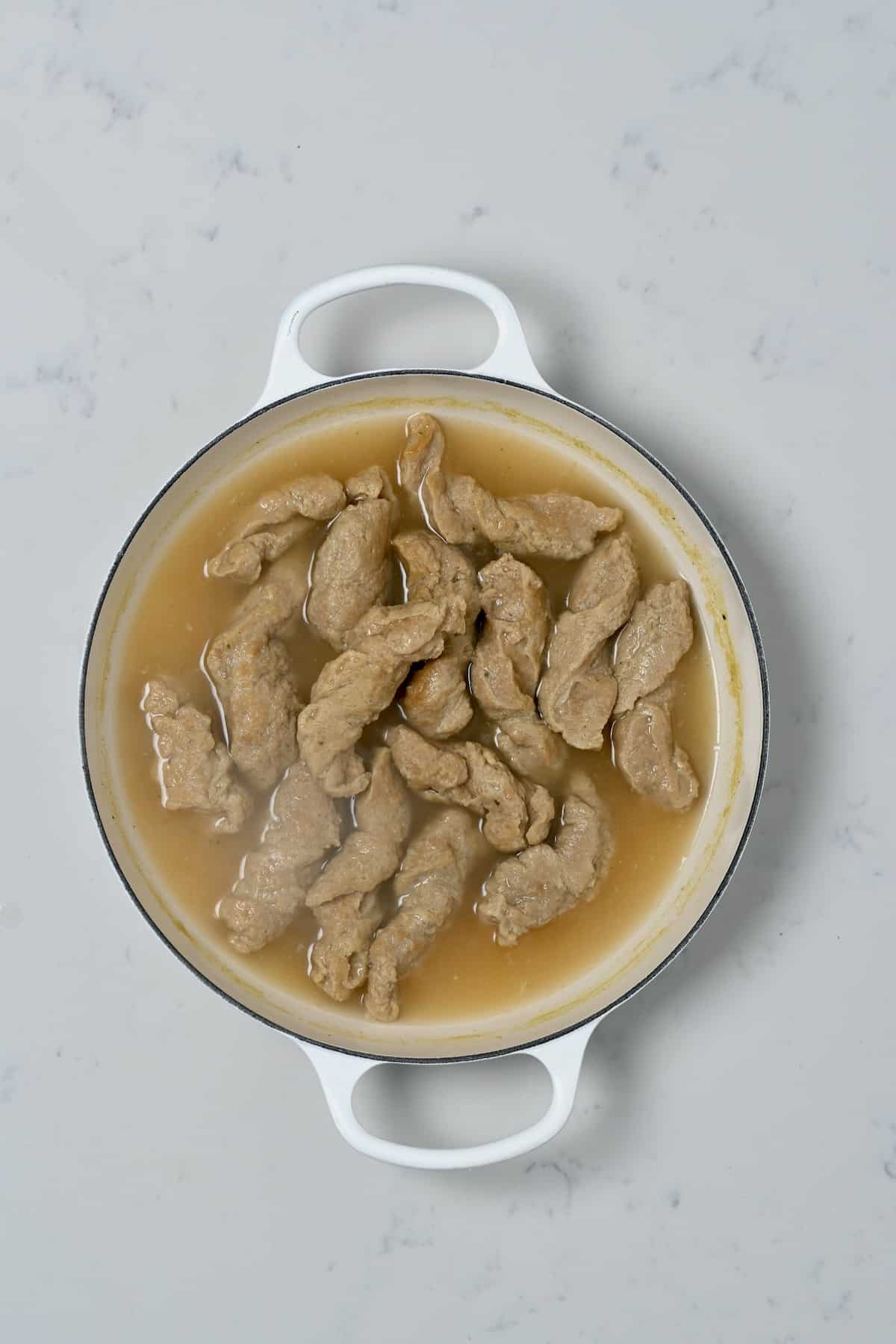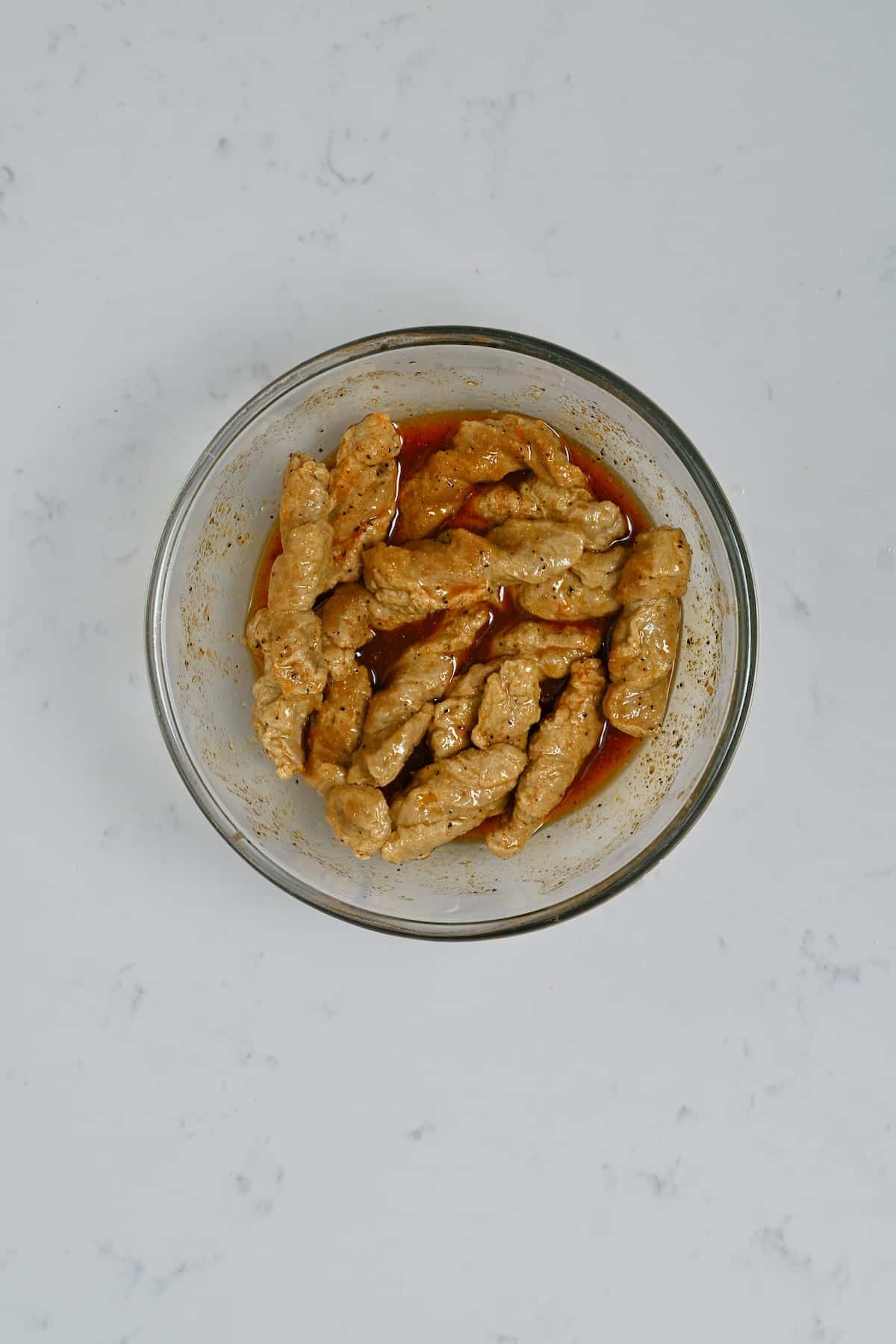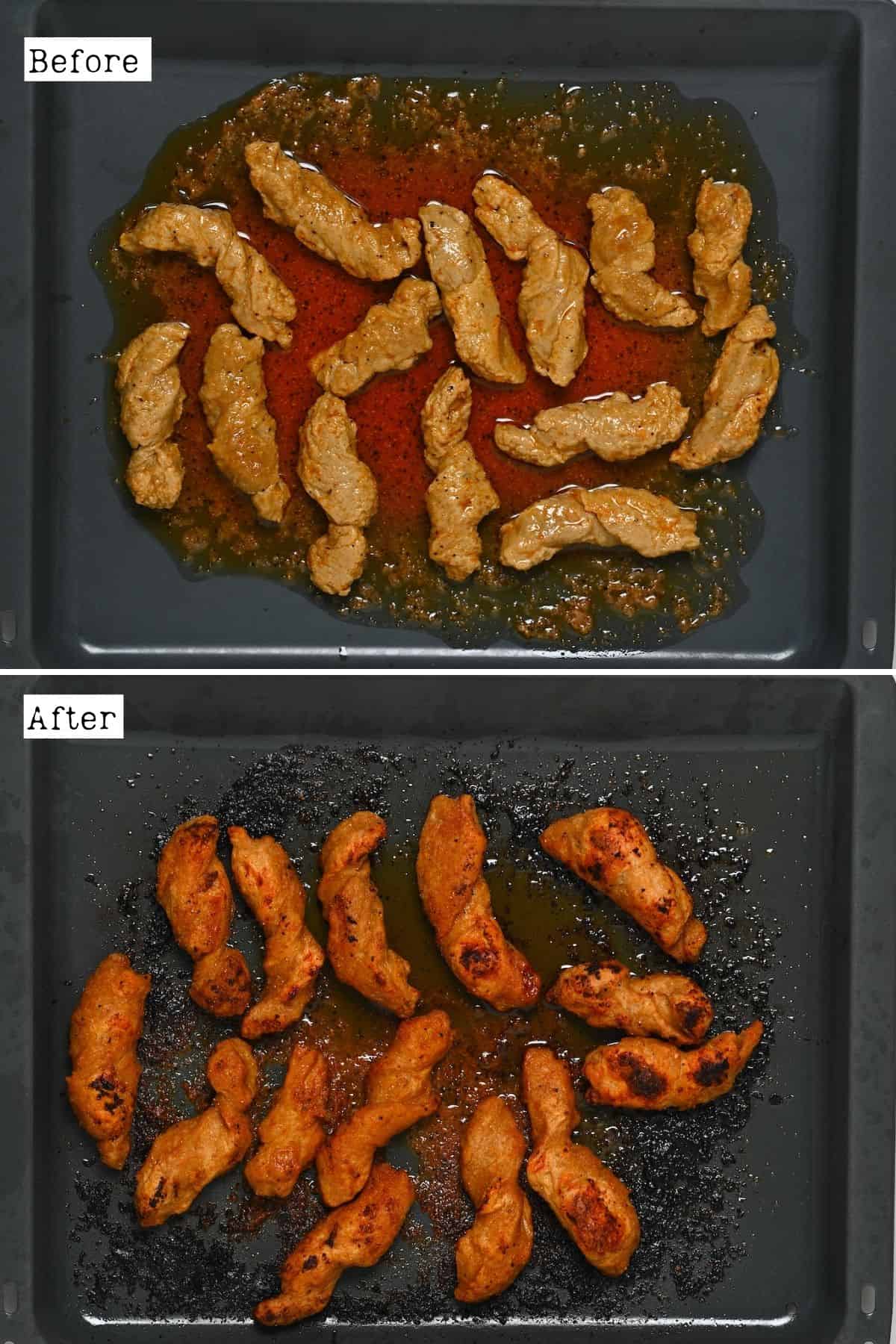This post may contain affiliate links. Please read our disclosure policy.
How to make seitan chicken with a flavorful “basic” seasoning ready to use as vegan chicken in all your favorite dishes! This beginner’s guide to seitan includes how to make and cook seitan (simmered or steamed), serving recommendations, top tips, and the answers to tons of top seitan FAQs!

If you enjoy or a meat-free diet, or know someone that does, then you’ve probably come across several types of meat alternatives in the market. I’ve already shared homemade tofu and tempeh methods, and now it’s time to learn how to make seitan. Seitan is the high-protein mock meat that’s been taking the internet by storm in 2021 (thanks to the “making chicken from flour” flour-wash method that went viral on TikTok).
This basic seitan chicken recipe is lightly flavored to become a super versatile vegan chicken. You can shape it, shred it, crumble it, slice it, cube it, etc. The possibilities are practically endless.
Best of all, the process for vegan chicken seitan is surprisingly simple too – with tons of versatility through the first cooking method, seasoning, second cooking method, and more. So let’s jump right in!

Want to save this recipe?
What is Seitan?
Seitan is a versatile vegan protein made from vital wheat gluten (the protein found in wheat) and perfect for turning into a high-protein vegan chicken, turkey, beef, etc. Not only is it one of the highest protein meat-free proteins, but it also has a firm, chewy (“meaty”) texture once cooked.
While I don’t know the exact origins of seitan, many believe it first originated as a popular food for vegetarian Buddhists in China in the 6th century! However, it is now extremely popular not just in Asian cuisine but globally (particularly within the last decade with the rise of meat-free/vegan lifestyles).
For this post, though, we’re focusing on seitan chicken. While it’s possible to buy it ready-made in shops, a homemade chicken seitan recipe allows you to control the flavor, saltiness, shape, etc. Even better, homemade seitan meat is far more frugal (by a landslide) than buying it ready-made from a store … even more so if you make your own vital wheat gluten (VWG)!

There are two ways to make homemade seitan: the first uses a washed flour method (starting with all-purpose flour but a longer, more arduous process) OR using vital wheat gluten (quick and simple!). I’ve already previously shared the washed flour method in my DIY for making homemade vital wheat gluten (I note at what point you’d use the vegan chicken or continue to make VWG powder). This time, though, I’m sharing how to prepare vital wheat gluten seitan for a super easy seitan recipe in a fraction of the time!
The Homemade Seitan Ingredients
- Vital wheat gluten: I used homemade vital wheat gluten (VWG), the key ingredient in this chicken seitan recipe. You could also use a store-bought option like Bob’s Red Mill.
- Chickpea flour: chickpea flour will add extra protein to the chicken seitan recipe and help break up the VWG for softer final seitan without affecting the flavor too much. Alternatively, you could try tapioca starch, soy flour, or all-purpose flour. If you omit it entirely, the seitan will be tougher.
- Seasonings: for a simple, all-purpose vegan chicken seasoning, use onion powder, garlic powder, and salt (or some soy sauce/GF tamari in the broth instead of salt).
- Vegetable stock: I use homemade vegetable stock (vegan chicken stock would also work). Use reduced-sodium stock if preferred (and adjust any remaining sodium in the recipe).
- Water: to help hydrate the dough. For more flavor, you could use more vegetable stock.

Optional Add-ins and Variations
When making this homemade seitan, I aim to make a neutral, all-purpose seasoned vegan chicken seitan that I can then further flavor and use in many recipes. Below are some options that will add extra flavor without changing the dish too much!
- Nutritional yeast: will add umami and depth of flavor. I recommend using around ¼ cup and reducing the chickpea flour.
- Paprika: ½-1 tsp of smoked paprika is a great flavor (and color) booster.
- Miso paste: for more umami, add a spoonful of miso paste to the dough.
- Liquid smoke: a few drops added to the broth when boiling will add a slightly smokey flavor to the seitan meat.
- Poultry seasoning: start with one teaspoon and increase in future batches, if preferred. Sometimes the easiest way to deal with mock meats is to use the same seasonings as you would the real thing.
- Vinegar: adding vinegar to the dough can help slightly offset the “gluten” flavor of the vital wheat gluten. I recommend using 1-2 Tbsp of apple cider vinegar. The actual flavor is fairly subtle within the seitan recipe.
- Baking soda: instead of vinegar, you could use baking soda (about ¼ tsp baking soda – not baking powder – per cup of VWG) to help offset the gluten flavor. If you use baking soda, don’t add any other acidic ingredients (vinegar, lemon, tomato paste, wine, etc.).
How to Make Seitan?
First, combine all the dry ingredients in a large mixing bowl (vital wheat gluten, chickpea flour, onion powder, garlic powder, and salt).
Then, gradually add the water (up to one cup), incorporating it into the mixture until you form a dough that’s wet but not sticky. If it feels dry, add an extra spoonful of water at a time.

Then, knead the dough on a clean kitchen surface for between 3-8 minutes to help develop the gluten.
The longer you knead within that time frame, the more developed the dough will be for a nice, firm “chicken-y” texture. If you’d prefer a less chewy, more tender texture, then knead for less time. With a bit of experimentation, you’ll find your perfect level.
Then place the seitan dough back in the bowl and cover to rest for 5 minutes (and allow the gluten to relax). This will make the dough easier to roll/shape.

How to Cook Seitan?
There are two main ways to do the initial cooking of the seitan meat: boiling or steaming. The method you choose should depend on what you intend to use the homemade seitan chicken for (check the FAQs below).
First, shape and chop the prepared seitan dough. Some like to make a single large knot to turn into vegan shredded chicken. Alternatively, you can roll it into a log, chop it down into a few smaller pieces (like nuggets or simply smaller “rolls”), make flat cutlets, or even cube it.
I divided mine into smaller pieces and then twisted them to make seitan chicken “strips.”

To boil the seitan
Meanwhile, bring the veggie broth to a boil in a large pan, reduce the heat to a simmer, and add the seitan dough.
Cook, uncovered, for 50-60 minutes, until firm, making sure the heat is at a very low, barely simmering level.
Once ready, remove the pan from the heat and allow it to sit for a further 10-15 minutes before removing from the liquid.

To steam the seitan
After shaping/slicing the seitan pieces, place each one in a foil package (or parchment paper parcel). Leave some space for expansion, but not wrapped too loosely.
Transfer the packages to a steamer basket and steam the seitan for between 30-50 minutes until firm. To make sure it is fully cooked, you can use a thermometer to ensure the internal temperature has reached 190ºF/88ºC!
Note that the exact cooking time for the boiling or steaming methods will vary based on how large your pieces of dough are. Nugget-sized pieces will take 30-40 minutes, even smaller bite-sized pieces may take 15-20 minutes. Whereas large logs can take up to 80 minutes. If you end up steaming it using a stacked steamer, you’ll need to swap around the layers halfway, and the process can take up to two hours OR cook in batches.

What next?
At this point, you are technically already able to eat the seitan chicken as is (i.e., to make vegan chicken shawarma). HOWEVER, in most cases, you’ll now further season/marinate and cook the vegan chicken seitan to serve in your meal of choice.
The first cook is for shaping and texture. The second cook is when you’re adding it to your dish of choice in most cases. At that point, it can be baked, pan-fried, grilled, deep-fried, etc.

At this point, you’d also shred or grind the cooked seitan. I prefer to do so after allowing it to cool in the fridge, so the texture has firmed up somewhat.
- Vegan shredded chicken: use a fork to scrape down the side of the seitan meat to shred it.
- To make chicken seitan crumbles: simply transfer the cooked seitan to a food processor and process it into your desired consistency. The ground seitan works wonderfully in place of ground meat in all sorts of recipes and for tacos.
How I cooked the seitan chicken? After the first boil, I allowed the vegan chicken to cool slightly. Next, spread the pieces on a parchment-lined baking tray and season. I seasoned it with lemon juice, olive oil, paprika, black pepper, salt, cardamom powder, coriander powder, ginger powder, and finely minced garlic. Then roast for 10-15 minutes at 425ºF/220ºC. I served it with freekeh and veggies!

How to Use Seitan?
As with tofu, tempeh, and other mock meats (like tofu ground beef), there are tons of ways to enjoy homemade seitan chicken. Some of my favorite options include:
- To make vegan shredded chicken for wraps and any dish to replace regular shredded meat.
- Added into tacos and burritos (either as shreds or ground seitan).
- To make vegan chicken shawarma and in pita sandwiches.
- Use ground seitan in place of ground meat in sauces and sprinkle over pizza.
- Marinate/season and cook to serve with the grain of your choice (like rice, quinoa, or freekeh).
- Chop and use the seitan meat within salads (like a vegan chicken Caesar salad)
- Slice like chicken ham and use within sandwiches.
- Add to curries – like this Thai red curry, Thai green curry, Indian butter chicken, etc.
- Add to soups and stews (usually shredded or in small cubes) – like in this fasolia or this molokhia recipe.
How Make Ahead and Store?
Make ahead: when making a large batch of homemade seitan, you can freeze leftover UNCOOKED seitan to use later (for up to 2 months). Note that frozen and thawed homemade seitan is usually slightly chewier (but many prefer this texture). Before cooking, thaw it in the refrigerator for several hours.
You can also store the prepared seitan dough wrapped tightly in the fridge for up to 12 hours before shaping and cooking.
Store: allow the vegan chicken seitan to cool and then store in an airtight container in the refrigerator with or without the broth (store for 7-10 days with broth, 5 days without). If storing without broth, I prefer to double wrap it with plastic wrap/beeswax wrap and then in a Ziplock bag and store for 4-5 days. Make sure it’s tightly wrapped/airtight to avoid the seitan drying out.
According to The Vegan Society, if you re-boil the seitan in the stock every 3-4 days, it can help to extend its shelf life (almost indefinitely).
Freeze: transfer the cooled homemade seitan chicken to a freezer-safe container or Ziplock bag and store for between 3-4 months (with or without the broth, if boiled).
Reheat: just like the versatile cooking options, you can reheat the seitan meat in several ways, too: microwave, pan-frying, baking, etc. It’s best to add some liquid when reheating, though, to avoid it drying out.

FAQs
The base for seitan is vital wheat gluten, hydrated with some liquid and the seasonings of your choice. Here, I’ve also added chickpea flour for a more tender seitan chicken rather than using pure VWG.
Seitan is a great plant-based lean protein, high in protein while low in carbs and fat (and calories)! It makes for a great soy-free meat alternative and isn’t overly processed. However, if you’re sensitive to gluten (as it’s wheat-based), then avoid it. You can read more about whether seitan is healthy if preferred.
Seitan is pronounced SAY-TAN (not Satan!).
Like most meat alternatives, the actual flavor of seitan is relatively mild (which is part of what makes it such a versatile vegan meat alternative). It’s slightly savory, with a slightly gluten-y (yeasty) flavor that works as the perfect “base” vegan chicken ready to marinate or further season to infuse it with your flavors of choice.
This comes down to what you intend to do with the homemade seitan once it’s cooked. Simmering in stock will allow the seitan to pick up the flavors from the stock but also yields a juicer, slightly fluffier (but not spongey) seitan chicken.
In comparison, steamed seitan will be slighter denser in the middle, and won’t contain as much liquid – making it the preferred choice when you want a crispier sear (like pan-frying/ stir-fries/grilling, etc.). Steaming is also usually slightly quicker.
Recipe Tips and Notes
- Don’t boil the seitan: if you do, it can become puffy and spongey, rather than having a denser, slightly chewy, more “meaty” texture.The water should be barely simmering.
- Experiment with seasonings: this easy seitan recipe is for a basic vegan chicken that’s versatile enough to use in various recipes (and to season further for different types of cuisine). However, feel free to experiment with other seasonings and flavorings.
- Adjust the amount of salt: if you plan on eating the vegan chicken “as is” after the first boil/steam, I recommend using extra salt in the dough. However, if you plan on further seasoning/marinating it and cooking again, reduce the amount.
- Use the leftover broth: you can use it when reheating the seitan or can be used to add to soups, stews, sauces, etc.
- If your stored seitan becomes a little dry: you can rehydrate it in a bowl of hot broth for 10-15 minutes. Alternatively, use it in saucy dishes.
- Allow the seitan to age: while you can technically use the vegan chicken seitan directly after steaming/simmering it, it’s best to allow it to rest and chill for 8-24 hours to achieve the best texture/consistency before further cooking/consuming the vegan chicken.
- The quickest cooking method: if you create small bite-sized seitan pieces, you can stem them in just 15 minutes, then follow up with a pan-fry to crisp up the outside (in just a few minutes with the glaze/ sauce of your choice) – enjoy!
More Vegan “Meat” Recipes
- Simple Indonesian Fried Tempeh (Tempe Goreng)
- Easy Vegan Bolognese (Spaghetti “Meat” Sauce)
- Crispy Baked Tofu (Breaded Tofu)
- Vegan Birria Tacos (Oyster Mushroom Tacos)
If you try this easy seitan recipe for vegan seitan chicken, I’d love to hear your thoughts/questions below. Also, I’d appreciate a recipe card rating below, and tag me in your recipe recreations on Instagram @Alphafoodie!

How to Make Seitan Chicken (Vegan Chicken)
Ingredients
- 1 cup vital wheat gluten I used homemade
- ¼ cup chickpea flour or soy flour/tapioca flour
- 1 tsp onion powder
- 1 tsp garlic powder
- ½ tsp salt
- ½-1 cup water or more veg stock, to hydrate the dough
To cook the dough/seitan
- 6 cups vegetable stock or vegan chicken stock; use reduced-sodium if preferred
Check the Recipe Notes below for more add-ins!
Instructions
How to Make Seitan?
- Combine all the dry ingredients in a large mixing bowl (vital wheat gluten, chickpea flour, onion powder, garlic powder, and salt).
- Gradually add the water (up to one cup), incorporating it into the mixture until you form a dough that’s wet but not sticky. If it feels dry, add an extra spoonful of water at a time.
- Knead the dough on a clean kitchen surface for between 3-8 minutes to help develop the gluten.The longer you knead within that time frame, the more developed the dough will be for a nice, firm "chicken-y" texture. If you’d prefer a less chewy, more tender texture, then knead for less time. With a bit of experimentation, you’ll find your perfect level.
- Place the seitan dough back in the bowl and cover to rest for 5 minutes (and allow the gluten to relax). This will make the dough easier to roll/shape.
How to Cook Seitan?
- There are two main ways to do the initial cooking of the seitan meat: boiling or steaming. The method you choose should depend on what you intend to use the homemade seitan chicken for (check the FAQs on the blog post).First, shape and chop the prepared seitan dough. Some like to make a single large knot to turn into vegan shredded chicken. Alternatively, you can roll it into a log, chop it down into a few smaller pieces (like nuggets or simply smaller "rolls"), make flat cutlets, or even cube it.I divided mine into smaller pieces and then twisted them to make seitan chicken "strips."
– To boil the seitan
- Bring the broth to a boil in a large pan, reduce the heat to a simmer, and add the seitan dough.
- Cook, uncovered, for 50-60 minutes, until firm, making sure the heat is at a very low, barely simmering level.
- Once ready, remove the pan from the heat and allow it to sit for a further 10-15 minutes before removing from the liquid.
– To steam the seitan
- After shaping/slicing the seitan pieces, place each one in a foil package (or parchment paper parcel). Leave some space for expansion, but not wrapped too loosely.
- Transfer the packages to a steamer basket and steam the seitan for between 30-50 minutes until firm.Note that the exact cooking time for the boiling or steaming methods will vary based on how large your pieces of dough are. Nugget-sized pieces will take 30-40 minutes, even smaller bite-sized pieces may take 15-20 minutes. Whereas large logs can take up to 80 minutes. If you end up steaming it using a stacked steamer, you’ll need to swap around the layers halfway, and the process can take up to two hours OR cook in batches.To make sure it is fully cooked, you can use a thermometer to ensure the internal temperature has reached 190ºF/88ºC!
The Next Step
- At this point, you are technically already able to eat the seitan chicken as is (i.e., to make vegan chicken shawarma). HOWEVER, in most cases, you’ll now further season/marinate and cook the vegan chicken seitan to serve in your meal of choice.The first cook is for shaping and texture. The second cook is when you’re actually adding it to your dish of choice in most cases. At that point, it can be baked, pan-fried, grilled, deep-fried, etc.
Check the blog post for further preparation and storage instructions!
Notes
- Don’t boil the seitan: if you do, it can become puffy and spongey, rather than having a denser, slightly chewy, more “meaty” texture. The water should be barely simmering.
- Experiment with seasonings: this easy seitan recipe is for a basic vegan chicken that’s versatile enough to use in various recipes (and to season further for different types of cuisine). However, feel free to experiment with other seasonings and flavorings.
- Adjust the amount of salt: if you plan on eating the vegan chicken “as is” after the first boil/steam, I recommend using extra salt in the dough. However, if you plan on further seasoning/marinating it and cooking again, reduce the amount.
- Use the leftover broth: you can use it when reheating the seitan or can be used to add to soups, stews, sauces, etc.
- If your stored seitan becomes a little dry: you can rehydrate it in a bowl of hot broth for 10-15 minutes. Alternatively, use it in saucy dishes.
- Allow the seitan to age: while you can technically use the vegan chicken seitan directly after steaming/simmering it, it’s best to allow it to rest and chill for 8-24 hours to achieve the best texture/consistency before further cooking/consuming the vegan chicken.
- The quickest cooking method: if you create small bite-sized seitan pieces, you can stem them in just 15 minutes, then follow up with a pan-fry to crisp up the outside (in just a few minutes with the glaze/sauce of your choice) – enjoy!
- Vegan shredded chicken: use a fork to scrape down the side of the seitan meat to shred it.
- chicken seitan crumbles: simply transfer the cooked seitan to a food processor and process it into your desired consistency. The ground seitan works wonderfully in place of ground meat in all sorts of recipes and for tacos.
- Nutritional yeast: will add umami and depth of flavor. I recommend using around ¼ cup and reducing the chickpea flour.
- Paprika: ½-1 tsp of smoked paprika is a great flavor (and color) booster.
- Miso paste: for more umami, add a spoonful of miso paste to the dough.
- Liquid smoke: a few drops added to the broth when boiling will add a slightly smokey flavor to the seitan meat.
- Poultry seasoning: start with one teaspoon and increase in future batches, if preferred. Sometimes the easiest way to deal with mock meats is to use the same seasonings as you would the real thing.
- Vinegar: adding vinegar to the dough can help slightly offset the ‘gluten’ flavor of the vital wheat gluten. I recommend using 1-2 Tbsp of apple cider vinegar. The actual flavor is fairly subtle within the seitan recipe.
- Baking soda: instead of vinegar, you could use baking soda (about ¼ tsp baking soda – not baking powder – per cup of VWG) to help offset the gluten flavor. If you use baking soda, don’t add any other acidic ingredients (vinegar, lemon, tomato paste, wine, etc.)
Nutrition
Nutrition information is automatically calculated, so should only be used as an approximation.


















I boiled the seitan and now it’s really expanded and become puffy and spongey. Can I still eat it?
Hi Julie,
You can still eat it if you are okay with the texture.
Easiest seitan recipe I’ve come across-made a double batch this time!
I’m learning kneading time makes all the difference: more kneading makes for great, bitey slices in many Asian dishes (curry/stirfry etc) whereas less kneading makes for more tender chunks/strips for wraps and nuggies.
A bit of Tamari in the simmering broth really rounds out the yum on this one.
Thanks for a great resource!
Thank you so much for your comment and tips, Ardi!
Hi Can this be frozen
Hi Jacqueline,
Yes, you can freeze it once it’s cooled down in a freezer-safe container or Ziplock bag for 3-4 months (with or without the broth, if boiled).
Loved this recipe!!! So so good! I added paprika, nooch, and apple cider vinegar (only 1 tbsp). It’s so versatile to use chicken in any recipe! I used it in a coq au vin recipe and 10/10 will make again
Thank you so much for your comment, Abigail. These additions sound delicious. And so does this version of coq au vin 🙂